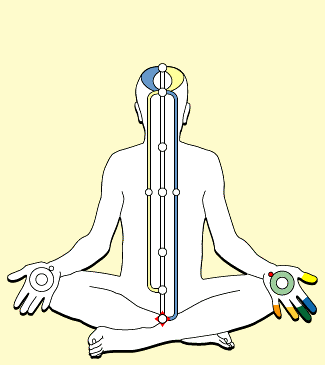

Kundalini means ‘coiled energy’ and it refers to a power which lies in three-and-a-half coils in the sacrum bone called the Mooladhara which is distinct from, and lies above, the Mooladhara Chakra. (It is interesting to note that sacrum if Greek for sacred.) A pulsation is sometimes seen at this level during Kundalini Awakening. Like the Sushumna, the Kundalini is normally in a potential state. When it is awakened it ascends through the Sushumna, across the void to the top of the Sushumna. When the Kundalini emerges at this point, Yoga is said to have taken place. Yoga is impossible without Kundalini Awakening.
This happening of Kundalini awakening and ultimate union with a higher consciousness are described by a Sanskrit word ‘Sahaja’. This means literally ‘born with,’ spontaneous or effortless. The implication is that the entire mechanism is inborn — part of human anatomy — and is activated in a spontaneous and natural way without undue or extreme efforts. One analogy often used is the germinating of a seed. This happens automatically when the seed is placed in the Mother Earth.
When the Kundalini reaches the Agnya Chakra, one becomes silent and peaceful. The person sits with his eyes closed, so this is not a state of hypnosis, brainwashing or manipulation — just silence. The person is fully aware of himself and of his surroundings and is he wishes to, he can think. However, the person is very relaxed and his attention is not constantly being distracted by the normal flow of mundane thoughts. This state is not achieved by any effort of will or by any mental exercises on the part of the patient. It occurs spontaneously when a Sahaja Yogi, that is to say someone who has the state of Yoga and the expertise of the mechanism, awakens the Kundalini. But this is also an illusion as it the Divine Presence within that gives Self-Realization.
If one of the Chakras is damaged or defective, the Kundalini may be obstructed at that level. In such cases, it is often possible to see the pulsation of the Kundalini at that level with the naked eye, and to hear it with a stethoscope. This pulsation can also be heard at the fontanel and Adi Shankaracharya called this 'spandakarika.'
As the Kundalini rises through the Agnya Chakra, it cools down the system, especially the cerebo-spinal fluid. This results in the balloons of the left and right Agnya becoming progressively deflated. Once this happens the Kundalini is able to reach the top of the Sushumna; the Sahasrara Chakra. At this point we can say that Yoga has taken place. The person feels the coolness, like a breeze of cool vibrations flowing in the fingers and palms of both hands. The sensations on the hands can, with very little practice, be used to ascertain the state of the Chakras. The nadis and the Chakras themselves begin to manifest in the conscious awareness, and what has so far been a hypothesis becomes part of one’s everyday sensory experience. Our fingertips, the base and center of the palm become extremely sensitive as the sympathetic nerve endings representing the different Chakras become enlightened. (According to the Prashna Upanishad, verse 3:6, there are precisely 727,210,201 nerves.) We can feel on our fingers our own selves and other people by a proper method of decoding, which can be taught to anyone who reaches this stage, in a month. Thus, the diagnosis takes place at a deeper level of our being through our sensitivity to these seven centers.
If one learns how to nourish the Chakras through the knowledge of Sahaja Yoga, one can cure the exhausted Chakras. Thus the patient is cured at the root of the disease. It is a scientific and logical method that exists naturally within ourselves, which gives us a balance, redeems us of our mental and physical troubles, comforts and counsels us.